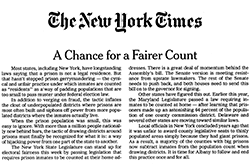Back and forth in the Buffalo News
by Aleks Kajstura, July 19, 2010
The Buffalo News recently published a brief mention of prison-based gerrymandering, and in response I wrote a letter to the editor explaining that the current efforts to end prison-based gerrymandering in New York would have no impact on federal or state aid to communities with prisons.
The News recently printed a response to my letter from a Buffalo resident, Larry McMahon. The response letter claimed that I “omit[ed] that prisons are likely to be a financial strain on the communities in which they are located.” While I agree that prisons are a strain on their local communities, the solution is for those local governments to require the state cover both direct and indirect expenses of incarceration. When a community suffers because the state is not paying for the full costs of incarceration, the answer is to seek redress in kind from the state, not stuff the ballot box.
The writer claims that “if anybody is guilty of gerrymandering in this circumstance, it’s the Prison Policy Initiative….
Citizens who live in communities that host prisons are just as entitled to fair and equal representation as anybody else. Misrepresenting their actual population —by counting the incarcerated somewhere else and thereby lowering their representation—would limit their ability to be fairly remunerated by the Legislature for the additional services the care of inmates require.”(Emphasis added.)
New York districts are currently “misrepresenting their actual population.” The New York constitution quite clearly states that “no person shall be deemed to have gained or lost a residence… while confined in any public prison.” (New York Constitution, Article II, § 4.) Districts that contain prisons are currently getting more political clout in the legislature than their actual resident population warrants. Using incarcerated people as phantom constituents to pad these districts is “misrepresenting their actual population.”




